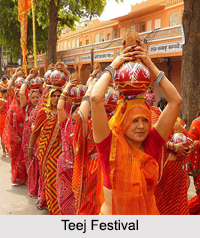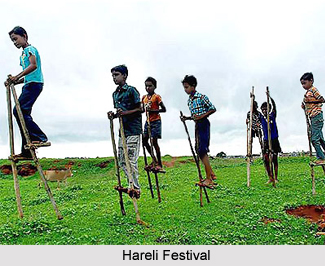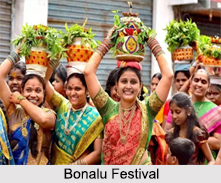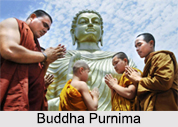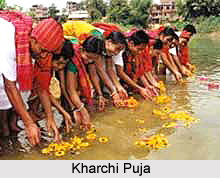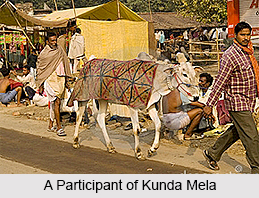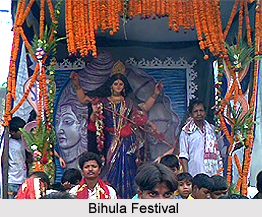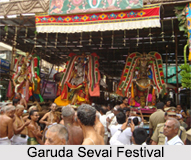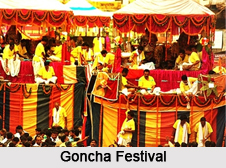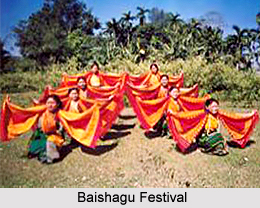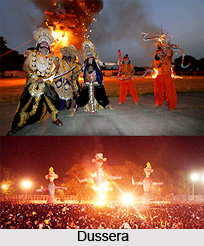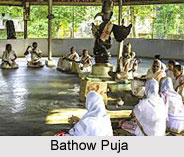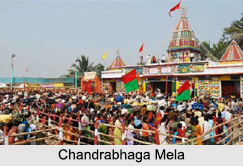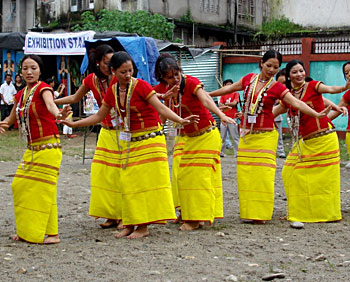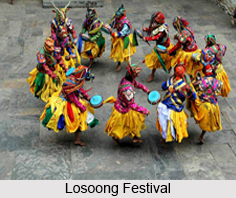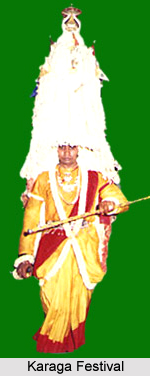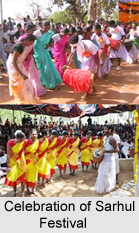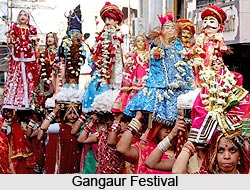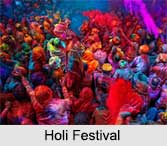 Holi is celebrated across the corners of India and is one of the major festivals of India and is the most vibrant of all. It symbolizes dawn, light, life and a flow of energy which suggests the destruction of evil and a hope of good. It is one of the most popular festivals celebrated in India which is celebrated on the full moon day in the month of Phalguna of February – March. The name "Holi" comes from "Holika", the sister of demon King Hiranyakashyap.
Holi is celebrated across the corners of India and is one of the major festivals of India and is the most vibrant of all. It symbolizes dawn, light, life and a flow of energy which suggests the destruction of evil and a hope of good. It is one of the most popular festivals celebrated in India which is celebrated on the full moon day in the month of Phalguna of February – March. The name "Holi" comes from "Holika", the sister of demon King Hiranyakashyap.
Legends of Holi
Holi is an ancient Hindu religious festival which is an ancient Hindu festival with its cultural rituals. It is mentioned in the Puranas, Dasakumara Charita and by Kalidasa during the 4th century reign of Chandragupta II. The celebration of Holi is also mentioned in the 7th-century Sanskrit drama "Ratnavali". The most popular stories of Holi derivation relates to `Holika Dahan` and myth of Radha-Krishna.
The ceremony of Holi is figurative of victory of good over evil and has its origin in the legend of demon king Hiranyakashyap who wished to end his blessed son, Prahlad`s life with the help of his sister, Holika who was burnt and no harm occurred to Prahlad. Since then the day is celebrated in victory of good over bad. The tale of Radha and Krishna is closely concurrent with this tradition of colours on Holi. Another story states, Krishna was jealous of his beloved Radha`s tremendously fair skin. In a playful mood, he applied colour on Radha`s face. Following this myth, lovers colour their beloved as an expression of love till now.
Other legend behind the origin of Holi is that Lord Krishna, as a baby was poisoned by the breast milk of Putana and thus he developed the feature blue colour of his skin. He approached Radha and coloured her face with some colours. Radha accepted Krishna despite the blue colour of his skin and since that day the festival of Holi is celebrated.
Among other Hindu traditions such as Shaivism and Shaktism, the legendary significance of Holi is correlated to Shiva who was in yoga and goddess Parvati wanted to bring back Shiva into the real world, looking for help from the Hindu God of love called Kama on Vasant Panchami. The love God shoots arrows at Shiva and Shiva opened his third eye and burned Kama to ashes. This hurt both Kama`s wife Rati (Kamadevi) and his own wife Parvati. Rati performed her own meditative sobriety for forty days, upon which Shiva understood, forgave and restored the God of love. This return of the God of love is celebrated on the 40th day after Vasant Panchami festival as Holi.
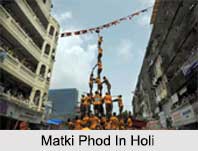 Celebrations of Holi in India
Celebrations of Holi in India
Holi is famous as "Vasant Utsav" in countryside India. "Gujiyas" and other sweets are offered to everyone who comes across to colour. Temples are magnificently decorated at the time of Holi and the idol of Radha is placed on swings and devotees turn the swings singing devotional Holi songs. Children of all age groups meet and celebrate the festival with great joy and vigour. They throw colours on each other and the family members.
Holi in Telangana: Here children celebrate "Kamuda" and collect money, rice, corn and wood for weeks prior to Holi, and on "Kamudha" night the wood is put together and set on the fire.
Holi in Jammu and Kashmir: In Jammu and Kashmir, Holi celebrations are a high-spirited festival to mark the beginning of the harvesting of the summer crop, with the throwing of coloured water and powder and singing and dancing.
Holi in Punjab: In Punjab, Holi is preceded by "Holika Dahan" the night before. On the day of Holi, people keep in throwing colours on each other and celebrate Holi.
Holi in Gujarat: Holi is a two-day festival in Gujarat. On the evening of the first day, people light the bonfire and present raw coconut and corn to the fire. The second day is the festival of colours or "Dhuleti", celebrated by smattering coloured water and applying colours to each other. In western India, a pot of buttermilk is hung high over the streets and young boys try to reach and break it by making human pyramids. The boy who finally manages to break the pot is crowned as the Holi King.
Holi in Uttar Pradesh: "Lath mar Holi" is celebrated in the sprawling compound of the Radha Rani Temple of Uttar Pradesh. In this festival, women beat up men, sing Holi songs and shout "Sri Radhey" or "Sri Krishna". In Mathura, Holi is celebrated with special puja by worshipping Lord Krishna. Here the festival lasts for sixteen days. A traditional celebration includes "Matki Phod" in the remembrance of Lord Krishna who is also called as "makhan chor". In the Kanpur area, a grand fair called "Ganga Mela" or the "Holi Mela" is celebrated on the last day of the festival. In Gorakhpur, the day starts with a special puja called "Holi Milan".
Holi in Uttarakhand: "Kumaoni Holi" in Uttarakhand includes a musical affair which takes different forms such as the "Baithki Holi", the "Khari Holi" and the "Mahila Holi". In the Kumaon region, the Holika pyre, known as "Cheer" is ceremonially built in a ceremony known as "Cheer Bandhan".
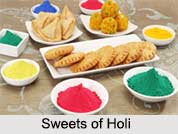 Holi in Bihar: Holi is known as "Phaguwa" in this region. People light bonfires, put dried cow dung, wood of the "Araad" or "Redi" tree and Holika tree, grains from the fresh harvest and unwanted wood leaves in the bonfire. "Holi Milan" is also celebrated here, where family members visit each other`s family and apply colours on each other`s faces and on feet.
Holi in Bihar: Holi is known as "Phaguwa" in this region. People light bonfires, put dried cow dung, wood of the "Araad" or "Redi" tree and Holika tree, grains from the fresh harvest and unwanted wood leaves in the bonfire. "Holi Milan" is also celebrated here, where family members visit each other`s family and apply colours on each other`s faces and on feet.
Holi in Odisha: The people of Odisha celebrate "Dola" on the day of Holi where the icons of Jagannath replace the icons of Krishna and Radha.
Holi in West Bengal: Holi is known by the name of "Dol Jatra", "Dol Purnima" or the "Swing Festival" is celebrated here. The festival is celebrated in a dignified manner by placing the icons of Krishna and Radha on an attractively decorated palanquin which is then taken round the main streets. People sing and dance to the addition of musical instruments, such as the "ektara", "dubri", and "veena". The devotees take turns to swing them while women dance around the swing and sing devotional songs. During these activities, men keep spraying coloured water and coloured powder.
Holi in Assam: It is also called "Phakuwa" in Assamese and is celebrated all over Assam. On the first day, the burning of clay huts is seen in Barpeta and lower Assam which signifies the legends of Holika. On the second day of it, Holi is celebrated with colour powders.
Holi in Goa: Holi is locally called "Ukkuli" in Konkani and is celebrated around the Konkani temple. It is a part of the Goan or Konkani spring festival known as "Sigmo". Holi festivities include "Holika Puja" and "Dahan", "Dhulvad" or "Dhuli vandan", "Haldune" or offering yellow and saffron colour or Gulal to the God.
Holi in Maharashtra: In Maharashtra, Holi Purnima is also celebrated as "Shimga", festivities that last five to seven days. A week before the festival, youngsters go around the community, collecting firewood and money. On the day of "Shimga", the firewood is heaped into a vast pile in each neighbourhood. In the evening, the fire is lit. Every household brings a meal and dessert, in the honour of the fire God.
Holi in Manipur: Manipur celebrates Holi for 6 days. Here, this holiday combines with the festival of "Yaosang". The festival starts with the burning of a hut of hay and twigs. Young children go from house to house to gather money, locally known as "nakadeng" as gifts on the first two days. The youths at night perform a group folk dance called "Thabal chongba" on the full moon night of Lamta.
Holi in Karnataka: Here children collect money and wood weeks prior to Holi, and on "Kamadahana" night all the wood is put together and lit. The festival is celebrated for two days.
Holi in Delhi: Here people move out and apply colour on each other. They play with colours peaks up and usually do not go out with families beyond their neighbourhood. Holi is also celebrated at the Presidents and Prime Minister Residences where people gather to play Holi.
In all the other parts of India, Holi is celebrated with great joy and happiness. Different names of Holi in various states of India:
•Uttar Pradesh - Lathmar Holi
•Uttarakhand - Khadi Holi
•Punjab - Hola Mohalla
•West Bengal - Basant Utsav and Dol Jatra
•Goa - Shigmo
•Manipur - Yaosang
•Kerala - Manjal Kuli
•Bihar - Phaguwa
•Assam - Phakuwah
•Maharashtra and Madhya Pradesh - Rang Panchami
•Rajasthan - Royal Holi
